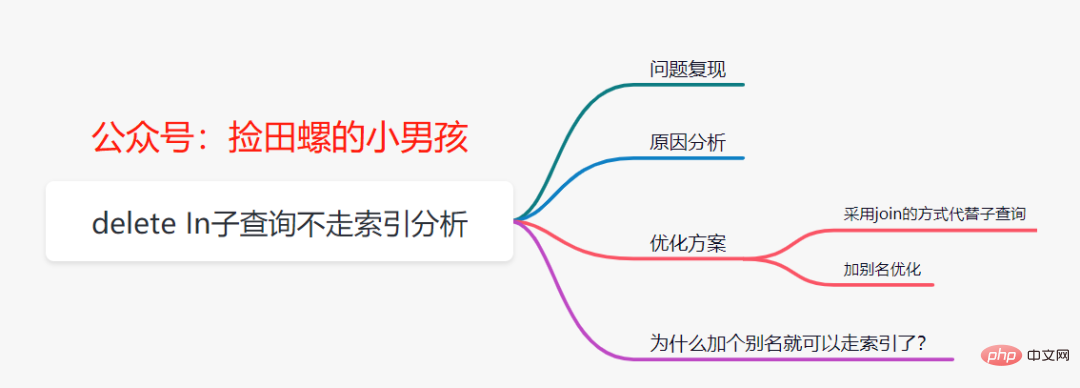 Database
Database
 Mysql Tutorial
Mysql Tutorial
 Analysis of the problem that delete in subquery does not go to the index in mysql
Analysis of the problem that delete in subquery does not go to the index in mysql
Analysis of the problem that delete in subquery does not go to the index in mysql
Recommended learning: mysql video tutorial
Before the article begins, let me ask you a question: delete in subquery , will it be indexed?? The first impression of many partners is that they know how to index. Recently we had a production problem related to it. This article will discuss this issue with everyone and attach an optimization plan.
 Problem Reproduction
Problem Reproduction
MySQL version is
5.7, assuming there are currently two tables account and old_account, the table structure is as follows: <div class="code" style="position:relative; padding:0px; margin:0px;"><pre class='brush:php;toolbar:false;'>CREATE TABLE `old_account` (
`id` int(11) NOT NULL AUTO_INCREMENT COMMENT &#39;主键Id&#39;,
`name` varchar(255) DEFAULT NULL COMMENT &#39;账户名&#39;,
`balance` int(11) DEFAULT NULL COMMENT &#39;余额&#39;,
`create_time` datetime NOT NULL COMMENT &#39;创建时间&#39;,
`update_time` datetime NOT NULL ON UPDATE CURRENT_TIMESTAMP COMMENT &#39;更新时间&#39;,
PRIMARY KEY (`id`),
KEY `idx_name` (`name`) USING BTREE
) ENGINE=InnoDB AUTO_INCREMENT=1570068 DEFAULT CHARSET=utf8 ROW_FORMAT=REDUNDANT COMMENT=&#39;老的账户表&#39;;
CREATE TABLE `account` (
`id` int(11) NOT NULL AUTO_INCREMENT COMMENT &#39;主键Id&#39;,
`name` varchar(255) DEFAULT NULL COMMENT &#39;账户名&#39;,
`balance` int(11) DEFAULT NULL COMMENT &#39;余额&#39;,
`create_time` datetime NOT NULL COMMENT &#39;创建时间&#39;,
`update_time` datetime NOT NULL ON UPDATE CURRENT_TIMESTAMP COMMENT &#39;更新时间&#39;,
PRIMARY KEY (`id`),
KEY `idx_name` (`name`) USING BTREE
) ENGINE=InnoDB AUTO_INCREMENT=1570068 DEFAULT CHARSET=utf8 ROW_FORMAT=REDUNDANT COMMENT=&#39;账户表&#39;;</pre><div class="contentsignin">Copy after login</div></div>The executed SQL is as follows:
delete from account where name in (select name from old_account);
Let’s explain the execution plan,
 From the
From the
results, we can find: firstscan the whole table account, and then execute the subquery row by row to determine whether the conditions are met; obviously, this execution plan and We expected it not to match, because did not go to index . But if
is replaced with select, the index will be used. As follows:
 Why does the
Why does the
subquery go through the index, but the delete in subquery does not go through the index? Cause Analysis
What is the difference between the select in subquery statement and the delete in subquery statement? Let’s execute the following SQL to see
explain select * from account where name in (select name from old_account); show WARNINGS;
show WARNINGSselect `test2`.`account`.`id` AS `id`,`test2`.`account`.`name` AS `name`,`test2`.`account` .`balance` AS `balance`,`test2`.`account`.`create_time` AS `create_time`,`test2`.`account`.`update_time` AS `update_time` from `test2`.`account`You can view the final executed sql after optimization
The results are as follows :
semi join (`test2`.`old_account`)select in subquerywhere (`test2`.`account`.`name` = `test2`.`old_account`.`name`)
It can be found that during actual execution, MySQL optimized the
and changed the subquery to a join method, so the index can be used. But unfortunately, MySQL did not optimize it for delete in subquery. Optimization plan
So how to optimize this problem? Through the above analysis, it is obvious that the delete in subquery can be changed to
join. After we change to the join method, let's explain again:
 #We can find that the change to the join method is
#We can find that the change to the join method is
In fact, for update or delete subquery statements, MySQL official website
also recommends join method optimizationIn fact, Adding an alias to the table can also solve this problem, as follows: 
explain delete a from account as a where a.name in (select name from old_account)
Why can adding an alias enable indexing? 
what
? Why is it possible to add an alias, delete in subquery, and use the index again?Let’s go back and look at explain’s execution plan. We can find that in the Extra column, there is LooseScan
.
 What is LooseScan?
What is LooseScan?
semi join subquery. Because the subquery is changed to join, the delete in subquery can be indexed; If you add an alias
, it will use theLooseScan strategy, and the LooseScan strategy is essentially It is an execution strategy of semi join subquery. Therefore, adding an alias allows the delete in subquery to be indexed!
Recommended learning:mysql video tutorial
The above is the detailed content of Analysis of the problem that delete in subquery does not go to the index in mysql. For more information, please follow other related articles on the PHP Chinese website!

Hot AI Tools

Undresser.AI Undress
AI-powered app for creating realistic nude photos

AI Clothes Remover
Online AI tool for removing clothes from photos.

Undress AI Tool
Undress images for free

Clothoff.io
AI clothes remover

AI Hentai Generator
Generate AI Hentai for free.

Hot Article

Hot Tools

Notepad++7.3.1
Easy-to-use and free code editor

SublimeText3 Chinese version
Chinese version, very easy to use

Zend Studio 13.0.1
Powerful PHP integrated development environment

Dreamweaver CS6
Visual web development tools

SublimeText3 Mac version
God-level code editing software (SublimeText3)

Hot Topics
 1386
1386
 52
52
 MySQL: Simple Concepts for Easy Learning
Apr 10, 2025 am 09:29 AM
MySQL: Simple Concepts for Easy Learning
Apr 10, 2025 am 09:29 AM
MySQL is an open source relational database management system. 1) Create database and tables: Use the CREATEDATABASE and CREATETABLE commands. 2) Basic operations: INSERT, UPDATE, DELETE and SELECT. 3) Advanced operations: JOIN, subquery and transaction processing. 4) Debugging skills: Check syntax, data type and permissions. 5) Optimization suggestions: Use indexes, avoid SELECT* and use transactions.
 How to open phpmyadmin
Apr 10, 2025 pm 10:51 PM
How to open phpmyadmin
Apr 10, 2025 pm 10:51 PM
You can open phpMyAdmin through the following steps: 1. Log in to the website control panel; 2. Find and click the phpMyAdmin icon; 3. Enter MySQL credentials; 4. Click "Login".
 MySQL: An Introduction to the World's Most Popular Database
Apr 12, 2025 am 12:18 AM
MySQL: An Introduction to the World's Most Popular Database
Apr 12, 2025 am 12:18 AM
MySQL is an open source relational database management system, mainly used to store and retrieve data quickly and reliably. Its working principle includes client requests, query resolution, execution of queries and return results. Examples of usage include creating tables, inserting and querying data, and advanced features such as JOIN operations. Common errors involve SQL syntax, data types, and permissions, and optimization suggestions include the use of indexes, optimized queries, and partitioning of tables.
 Why Use MySQL? Benefits and Advantages
Apr 12, 2025 am 12:17 AM
Why Use MySQL? Benefits and Advantages
Apr 12, 2025 am 12:17 AM
MySQL is chosen for its performance, reliability, ease of use, and community support. 1.MySQL provides efficient data storage and retrieval functions, supporting multiple data types and advanced query operations. 2. Adopt client-server architecture and multiple storage engines to support transaction and query optimization. 3. Easy to use, supports a variety of operating systems and programming languages. 4. Have strong community support and provide rich resources and solutions.
 How to use single threaded redis
Apr 10, 2025 pm 07:12 PM
How to use single threaded redis
Apr 10, 2025 pm 07:12 PM
Redis uses a single threaded architecture to provide high performance, simplicity, and consistency. It utilizes I/O multiplexing, event loops, non-blocking I/O, and shared memory to improve concurrency, but with limitations of concurrency limitations, single point of failure, and unsuitable for write-intensive workloads.
 MySQL and SQL: Essential Skills for Developers
Apr 10, 2025 am 09:30 AM
MySQL and SQL: Essential Skills for Developers
Apr 10, 2025 am 09:30 AM
MySQL and SQL are essential skills for developers. 1.MySQL is an open source relational database management system, and SQL is the standard language used to manage and operate databases. 2.MySQL supports multiple storage engines through efficient data storage and retrieval functions, and SQL completes complex data operations through simple statements. 3. Examples of usage include basic queries and advanced queries, such as filtering and sorting by condition. 4. Common errors include syntax errors and performance issues, which can be optimized by checking SQL statements and using EXPLAIN commands. 5. Performance optimization techniques include using indexes, avoiding full table scanning, optimizing JOIN operations and improving code readability.
 MySQL's Place: Databases and Programming
Apr 13, 2025 am 12:18 AM
MySQL's Place: Databases and Programming
Apr 13, 2025 am 12:18 AM
MySQL's position in databases and programming is very important. It is an open source relational database management system that is widely used in various application scenarios. 1) MySQL provides efficient data storage, organization and retrieval functions, supporting Web, mobile and enterprise-level systems. 2) It uses a client-server architecture, supports multiple storage engines and index optimization. 3) Basic usages include creating tables and inserting data, and advanced usages involve multi-table JOINs and complex queries. 4) Frequently asked questions such as SQL syntax errors and performance issues can be debugged through the EXPLAIN command and slow query log. 5) Performance optimization methods include rational use of indexes, optimized query and use of caches. Best practices include using transactions and PreparedStatemen
 Monitor Redis Droplet with Redis Exporter Service
Apr 10, 2025 pm 01:36 PM
Monitor Redis Droplet with Redis Exporter Service
Apr 10, 2025 pm 01:36 PM
Effective monitoring of Redis databases is critical to maintaining optimal performance, identifying potential bottlenecks, and ensuring overall system reliability. Redis Exporter Service is a powerful utility designed to monitor Redis databases using Prometheus. This tutorial will guide you through the complete setup and configuration of Redis Exporter Service, ensuring you seamlessly build monitoring solutions. By studying this tutorial, you will achieve fully operational monitoring settings




